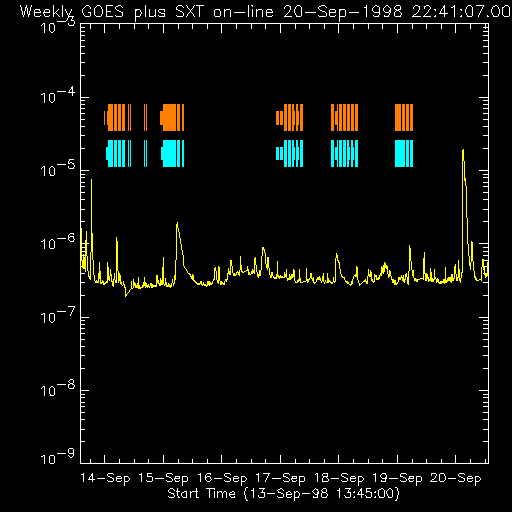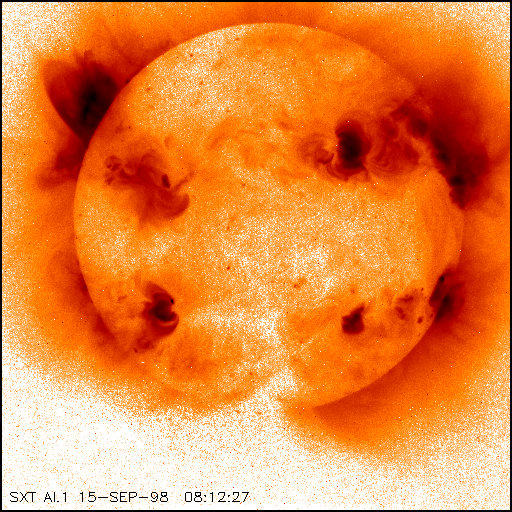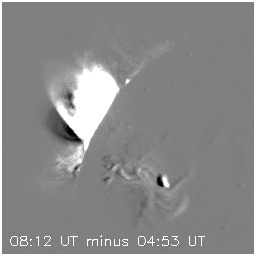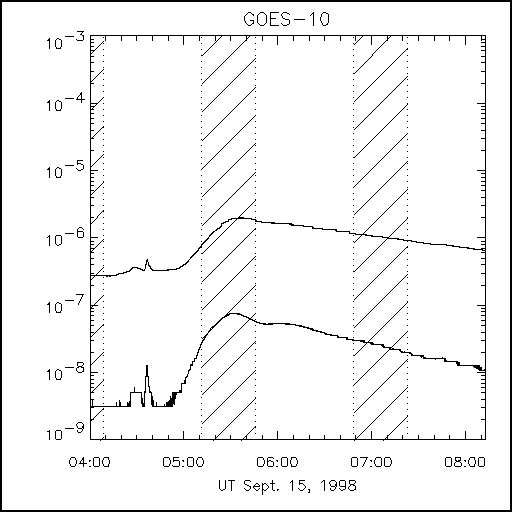
(Week 38, 1998)
The Soft X-ray Telescope operated well as usual. We carried out some limited observations in support of a La Palma/TRACE campaign led by Karin Muglach. See the weekly operations report for details. There were no M- or X-class flares during the week, for a change. However the C2 LDE event on September 15 arose in a far-over-the-limb active region and was a lot bigger than it looked - the iceberg effect.

In the display above (click to enlarge), the colored lines show the times of SXT images that currently are on-line at ISAS. The purple lines are flare mode. The gaps will be considerably reduced when the NASA telemetry arrives and gets reformatted. For a summary index listing of the weekly science reports, click here.
From the active-region history subsequent to the September 15 LDE event, we infer that it originated in NOAA AR #8338, which was at about the right latitude. A larger sunspot group at about the same longitude (AR #8440) was at about N22 and was presumably involved because of the size of the arcade that developed: The longitude of NOAA AR #8338 suggests that it was about 21 degrees beyond the limb, corresponding to a vertical height separation of about 50,000 km. The pre-event structure already rose to some 100 SXT pixels above the limb, perhaps 1/3 of a solar radius.

Note incidentally that even though this is a "thin aluminum" image from SXT, recorded almost 6 years after the rupture of the SXT thermal prefilter, almost no trace of stray light is present. In particular the dreaded pinhole brightening at the SE limb has been corrected beautifully.
Why are over-the-limb events interesting? We identify giant arcade events such as this with CME launching, and now have the "dimming" signature (see below) to clarify this point. The flares associated with such coronal restructurings and/or eruptions clearly differ from their more compact counterparts, although the latter frequently show ejecta too - type III bursts, sprays, and even hot plasma sometimes.

This difference image shows a dark region seemingly peeping out from behind the bright flare loops. This is the pre-event structure which disappeared during the flare, no doubt resulting in a spectacular CME. When SOHO is back... this would have been wonderful to observe. In the meanwhile the Mauna Loa observatory was at night. Luckily Nobeyama was observing - please check out their tohban report for a nice view of the erupting prominence, including a .gif movie.
Interestingly enough, there was little hint of meter-wave activity during this major event. We might have expected type II and type IV emission. At the time of writing, no data were available from CGRO - Yohkoh's own hard X-ray instrument was blind during the interesting part of this event because of the poor timing of day and night (orbit night intervals for Yohkoh shown here as hashed regions):

In general, we would surely like to see the non-thermal counterparts of such events, high in the corona.